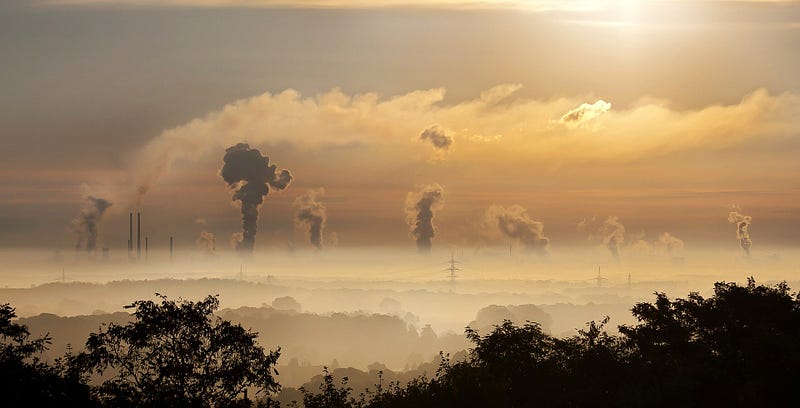Utter chaos: Tracking the dispersion of airborne pollutants
By Annabelle Mathers, Civil Engineering, 2022

Many processes in the natural and humanistic worlds are extraordinarily complex and seemingly random. However, in systems defined by Chaos Theory, this apparent randomness is actually not random at all, but governed by hidden patterns. Computer algorithms, biological responses, and weather are a few of the chaotic systems that express a constantly changing, never entirely predictable state of organization rooted in patterns. Likewise, the global dispersion of airborne pollutants consists of particle routes that are chaotic, or more specifically, deterministically chaotic.
A subset of Chaos Theory, deterministic chaos intrinsically links order and disorder, claiming that initial conditions in a constantly changing system result in the exponential growth of the number of future scenarios. Each scenario has nuanced characteristics and events that create countless cascading outcomes. The particular combination of events and characteristics causes future scenarios to exponentially diverge from and become semi-unique. Thus, a disordered picture forms from a series of ordered events. An example of such chaos is the Butterfly Effect, described by Edward Lorenz, where the wind from an Amazonian butterfly’s flapping wings causes a sequence of seemingly unrelated events that includes a tornado in Texas.
Deterministic chaos intrinsically links order and disorder, claiming that initial conditions in a constantly changing system result in the exponential growth of the number of future scenarios.
In a 2019 study, Tímea Haszpra of Eötvös Loránd University applies this concept to atmospheric aerosol particles. Volcanic ash and industrial air pollutants make up these particles, which form colloidal suspensions in the air that do not readily settle. Research data for wind and atmospheric conditions enabled Haszpra to create maps, using principles from Chaos Theory, that predict global particle dispersion. According to Haszpra, the initial altitude of a particle does not necessarily affect its escape rate from the atmosphere to the ground, but particle size has a quadratic influence on the escape rate. When paired with geographic location, this illustrates global areas most affected by the accumulation of airborne pollutants.
In order to reach these final locations, particles must travel along an atmospheric ‘chaotic saddle’ created by a combination of wind, atmospheric conditions, and particle size. The saddle itself functions as a boundary between stable and unstable states. Particles which congregate inside the saddle remain in stable colloidal suspension for a longer period of time; particles which exist outside or on the outskirts of the saddle are more unstable and scattered in their quicker descent to Earth. All particles within the saddle eventually fall to the ground, meaning the chaotic saddle is transient, or impermanent, by nature.
Particles must travel along an atmospheric ‘chaotic saddle’ created by a combination of wind, atmospheric conditions, and particle size.
Using particle trajectories calculated by a tracking program, RePLaT (Real Particle Lagrangian Trajectory), Haszpra reinforces the idea of locational stability and instability by estimating that the saddle can exist where stable particles maintain the greatest atmospheric lifetime and smallest escape rate. The tracking program relies on the principles of deterministic chaos, where circumstances and environmental nuances surrounding each particle over time all factor into the particle’s eventual behavior. A particle of a greater elevation at emission does not necessarily remain in the atmosphere, nor travel as far, as a particle of a lesser elevation. Then again, because of the sheer number of later events and characteristics that factor into the particle’s destiny, the previous statement does not always hold true. One characteristic that appears to maintain a more ‘predictable’ outcome is that particles with a larger radius will have a greater escape rate. This may seem like a simple application of gravitational principles, but when the idea of predictability in chaotic systems is not truly viable because of their infinitely complex nature, it is a significant recognition.
Because meteorological conditions are time-dependent, the chaotic saddle’s geographical location fluctuates over time. The saddle most often falls over equatorial tropical regions, which experience the highest concentration of persistent air pollutants from worldwide emissions. Converging southeast and northeast trade winds in the Intertropical Convergence Zone, along with atmospheric convection enabled by the warm equatorial surface, correlate with the saddle’s densest regions. Each condition affecting an individual particle has an exponential effect on its divergence from the paths of the other particles, meaning pollutants emitted in close proximity to one another can travel different paths toward extremely different locations. It may seem like the particles’ initial location and conditions become obsolete and detached from its final trajectory. However, it is now known through Chaos Theory that the origin story, and the origins of the innumerable factors affecting the particles along the way, are more important than ever.
DOI: 10.1063/1.5110385
